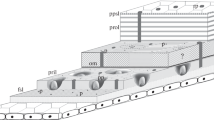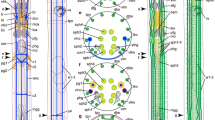Summary
About 1 s after appropriate stimulation, arms of Florometra serratissima break at articulations called syzygies that are specialized for autotomy. The fine structure of unreacted and of newly broken syzygies is described. The unreacted syzygy includes (1) ligament fibers consisting of collagen fibrils interconnected by interfibrillar strands and (2) axons filled with presumed neurosecretory granules. The newly broken syzygy includes (1) ruptured ligament fibers consisting of swollen collagen fibrils associated with interfibrillar globules and (2) axons containing few presumed neurosecretory granules, some of which are fixed in the act of exocytosis; moreover, the calcareous skeleton adjacent to the broken syzygy is partly eroded. The observations before and after breaking suggest that the autotomy mechanism may comprise the following sequence of events: rapid neural transmission from stimulation site to syzygy triggers a massive exocytosis of granules from presumed neurosecretory axons; the released neurosecretions (which could include chelating agents, strong acids, proteolytic enzymes or enzyme activators) etch the skeleton and lower the tensile strength of the ligament fibers by weakening the collagen fibrils and/or the interfibrillar material; breakage of the ligament fibers, the major connective tissue of the articulation, is quickly followed by rupture of all the other tissues at the syzygy.
Similar content being viewed by others
References
Bailey AJ (1968) Intermediate labile intermolecular crosslinks in collagen fibres. Biochim Biophys Acta 160:447–453
Breimer A (1978) General morphology, recent crinoids. In: Moore RC, Teichert C (eds) Treatise on Invertebrate Paleontology, Part T, Echinodermata 2, Vol. 1. Geol Soc Am. Boulder, Colorado, pp 9–58
Clark AH (1907) Description of new species of recent unstalked crinoids from the North Pacific Ocean. Proc US Nat Mus 33:69–84
Emson RH, Wilkie IC (1980) Fission and autotomy in echinoderms. Oceanogr Mar Biol Ann Rev 18:155–250
Goyette DE (1967) Light and electron microscope study of the aboral nervous system and neurosecretion in the crinoid Florometra serratissima. Master's Thesis, Univ Alberta, Edmonton, Canada
Grimmer JC, Holland ND (1979) Haemal and coelomic circulatory systems in the arms and pinnules of Florometra serratissima (Echinodermata: Crinoidea). Zoomorphologie 94:93–109
Holland ND, Jespersen ă (1973) The fine structure of the fertilization membrane of the feather star Comanthus japonica (Echinodermata: Crinoidea). Tissue Cell 5:209–214
Holland ND, Nealson KH (1978) The fine structure of the echinoderm cuticle and the subcuticular bacteria of echinoderms. Acta Zool (Stockh) 59:169–185
Holland ND, Grimmer JC (1981) Fine structure of the cirri and a possible mechanism for their motility in stalkless crinoids (Echinodermata). Cell Tissue Res 214:207–217
Junqueira LCU, Montes GS, Mourao PAS, Carneiro J, Salles LMM and Bonetti SS (1980) Collagen-Proteoglycans interaction during autotomy in the sea cucumber, Stichopus badionotus. Rev Can Biol 39:157–164
Luft JH (1971) Ruthenium red and violet. I. Chemistry, purification, methods of use for electron miroscopy and mechanism of action. Anat Rec 171:347–368
Meyer DL (1971) The collagenous nature of problematical ligaments in crinoids (Echinodermata). Mar Biol 9:235–241
Minafra S, Galante R, D'Antoni S, Fanara M, Coppola L, Pucci-Minafra I (1980) Collagen associated protein-polysaccharide in the Aristotle's lanternae of Paracentrotus lividus. J Submicrosc Cytol 12:255–265
Pentreath VB and Cobb JLS (1972) Neurobiology of Echinodermata. Biol Rev 47:363–392
Poole AR (1980) Proteinases of connective tissues. In: Naftolin F, Stubblefield PG (eds) Dilation of the uterine cervix. Raven Press, New York, pp 113–131
Pucci-Minafra I, Galante R, and Minafra S (1978) Identification of collagen in the Aristotle's lanternae of Paracentrotus lividus. J Submicrosc Cytol 10:53–64
Riedl H, Nemetschek T (1977) Molekularstruktur und mechanisches Verhalten von Kollagen. Sitzungsber Heidelb Akad Wiss, Math Naturw Kl, pp 217–248
Roubos EW, van der Wal-Divendal RM (1980) Ultrastructural analysis of peptide-hormone release by exocytosis. Cell Tissue Res 207:267–275
Takahashi K (1967) The catch apparatus of the sea-urchin spine. II Responses to stimuli. J Fac Sci Univ Tokyo (Sect 4) 11:121–130
Takahashi K (1975) Fine structure and mechanical properties of the catch apparatus of the spine of Anthocidaris crassispina. Zool Mag Tokyo 84:350
Takahashi K (1977) Effect of ionic environment on the mechanical properties of the catch apparatus of echinoid spine. Zool Mag Tokyo 86:391
Torp S, Baer E, Friedman B (1975) Effects of age and of mechanical deformation on the ultrastructure of tendon. In: Atkins EDT, Keller A (eds) Structure of fibrous biopolymers. Butterworths, London, pp 223–250
Wilkie IC (1978a) Nervously mediated change in the mechanical properties of a brittlestar ligament. Mar Behav Physiol 5:289–306
Wilkie IC (1978b) Arm autotomy in brittlestars (Echinodermata: Ophiuroidea). J Zool Lond 186:311–330
Wilkie IC (1979) The juxtaligamental cells of Ophiocomina nigra (Abildgaard) (Echinodermata: Ophiuroidea) and their possible role in mechano-effector function of collagenous tissue. Cell Tissue Res 197:515–530
Author information
Authors and Affiliations
Rights and permissions
About this article
Cite this article
Holland, N.D., Grimmer, J.C. Fine structure of syzygial articulations before and after arm autotomy in florometra serratissima (Echinodermata: Crinoidea). Zoomorphology 98, 169–183 (1981). https://doi.org/10.1007/BF00310434
Received:
Issue Date:
DOI: https://doi.org/10.1007/BF00310434




